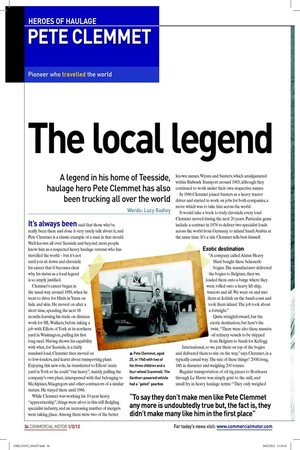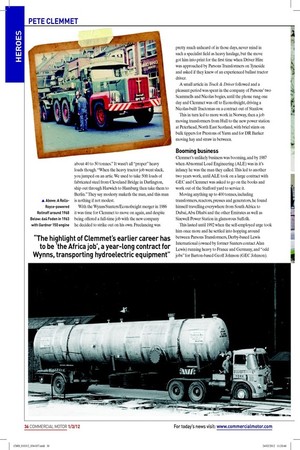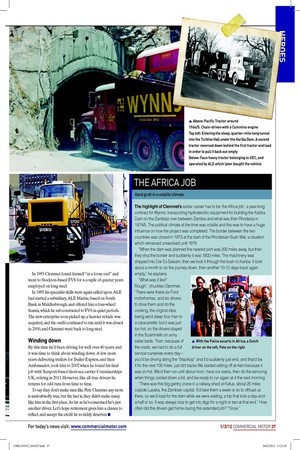HEROES OF HAULAGE
Page 27

Page 29

Page 30

If you've noticed an error in this article please click here to report it so we can fix it.
PETE CLEMMET
Pioneer who travelled the world
The local legend
A legend in his home of Teesside, haulage hero Pete Clemmet has also been trucking all over the world
Words: Lucy Radley It’s always been said that those who’ve
really been there and done it very rarely talk about it, and Pete Clemmet is a classic example of a man in that mould.
Well-known all over Teesside and beyond, most people know him as a respected heavy haulage veteran who has travelled the world – but it’s not until you sit down and chronicle his career that it becomes clear why his status as a local legend is so amply justiied.
Clemmet’s career began in the usual way around 1956, when he went to drive for Hirds in Yarm on hide and skin. He moved on after a short time, spending the next 18 months learning his trade on distance work for HL Walkers, before taking a job with Elliots of York at its northern yard in Washington, pulling his irst long steel. Having shown his capability with what, for Teesside, is a fairly standard load, Clemmet then moved on to low-loaders, and learnt about transporting plant.
Enjoying this new role, he transferred to Elliots’ main yard in York so he could “run heavy”, mainly pulling the company’s own plant, interspersed with that belonging to McAlpines, Macgregors and other contractors of a similar stature. He stayed there until 1966.
While Clemmet was working his 10-year heavy “apprenticeship” , things were afoot in this still ledgling specialist industry, and an increasing number of mergers were taking place. Among them were two of the better known names, Wynns and Sunters, which amalgamated within Bulwark Transport around 1963, although they continued to work under their own respective names.
In 1966 Clemmet joined Sunters as a heavy tractor driver and started to work on jobs for both companies, a move which was to take him across the world.
It would take a book to truly chronicle every load Clemmet moved during the next 20 years. Particular gems include a contract in 1976 to deliver two specialist loads across the world from Germany to inland Saudi Arabia at the same time. It’s a tale Clemmet tells best himself.
Exotic destination
“A company called Alatas Heavy Haul bought these Scheuerle bogies. The manufacturer delivered the bogies to Belgium, then we loaded them onto a barge where they were rolled onto a heavy lift ship, tractors and all. We went on and met them at Jeddah on the Saudi coast and took them inland. The job took about a fortnight.” Quite straightforward, bar the exotic destination, but here’s the twist. “There were also these massive oil reinery vessels to be shipped from Belgium to Saudi for Kellogg International, so we put them on top of the bogies and delivered them to site on the way,” says Clemmet, in a typically casual way. The size of these things? 200ft-long, 18ft in diameter and weighing 200 tonnes.
Regular transportation of oil rig pieces to Bordeaux through Le Havre was simply grist to the mill, and small fry in heavy haulage terms: “They only weighed about 40 to 50 tonnes.” It wasn’t all “proper” heavy loads though. “When the heavy tractor job went slack, you jumped on an artic. We used to take 50ft loads of fabricated steel from Cleveland Bridge in Darlington, ship out through Harwich to Hamburg then take them to Berlin.” They say modesty maketh the man, and this man is nothing if not modest.
With the Wynns/Sunters/Econofreight merger in 1986 it was time for Clemmet to move on again, and despite being offered a full-time job with the new company he decided to strike out on his own. Freelancing was pretty much unheard of in those days, never mind in such a specialist ield as heavy haulage, but the move got him into print for the irst time when Driver Hire was approached by Parsons Transformers on Tyneside and asked if they knew of an experienced ballast tractor driver.
A small article in Truck & Driver followed and a pleasant period was spent in the company of Parsons’ two Scammells and Nicolas bogies, until the phone rang one day and Clemmet was off to Econofreight, driving a Nicolas-built Tractomas on a contract out of Stanlow.
This in turn led to more work in Norway, then a job moving transformers from Hull to the new power station at Peterhead, North East Scotland, with brief stints on bulk tippers for Prestons of Yarm and for DR Barker moving hay and straw in between.
Booming business
Clemmet’s unlikely business was booming, and by 1987 when Abnormal Load Engineering (ALE) was in it’s infancy he was the man they called. This led to another two years work, until ALE took on a large contract with GEC and Clemmet was asked to go on the books and work out of the Stafford yard to service it.
Moving anything up to 400 tonnes, including transformers, reactors, presses and generators, he found himself travelling everywhere from South Africa to Dubai, Abu Dhabi and the other Emirates as well as Sizewell Power Station in glamorous Suffolk.
This lasted until 1992 when the self-employed urge took him once more and he settled into hopping around between Parsons Transformers, Derby-based Lewis International (owned by former Sunters contact Alan Lewis) running heavy to France and Germany, and “odd jobs” for Barton-based Geoff Johnson (GEC Johnson).
In 1993 Clemmet found himself “at a loose end” and went to Stockton-based FVS for a couple of quieter years employed on long steel.
In 1995 his specialist skills were again called upon. ALE had started a subsidiary, ALE Marine, based on South Bank in Middlesbrough, and offered him a four-wheel Scania, which he sub-contracted to FVS in quiet periods. The new enterprise soon picked up, a heavier vehicle was acquired, and the outit continued to run until it was closed in 2000, and Clemmet went back to long steel.
Winding down
By this time he’d been driving for well over 40 years, and it was time to think about winding down. A few more years delivering trailers for Trailer Express, and then Ambassador, took him to 2007, when he found his inal job with Teesport-based short-sea carrier Containerships UK, retiring in 2011. However, like all true drivers he returns for odd runs from time to time.
To say they don’t make men like Pete Clemmet any more is undoubtedly true, but the fact is, they didn’t make many like him in the irst place. As far as he’s concerned he’s just another driver. Let’s hope retirement gives him a chance to relect, and accept the credit he so richly deserves. n
THE AFRICA JOB
Hard graft in a volatile climate The highlight of Clemmet’s earlier career has to be ‘the Africa job’, a year-long contract for Wynns, transporting hydroelectric equipment for building the Kariba Dam on the Zambezi river between Zambia and what was then Rhodesia in 1974/5. The political climate at the time was volatile and this was to have a huge influence on how the project was completed. The border between the two countries was closed in 1973 at the start of the Rhodesian Bush War, a situation which remained unresolved until 1978.
“When the dam was planned the nearest port was 200 miles away, but then they shut the border and suddenly it was 1800 miles. The machinery was shipped into Dar Es Salaam, then we took it through the bush to Kariba. It took about a month to do the journey down, then another 10-12 days back again empty,” he explains.
“What was it like?
Rough,” chuckles Clemmet. “There were these six Ford motorhomes, and six drivers to drive them and do the cooking, the original idea being we’d sleep four men to a caravanette; but it was just too hot, so the drivers stayed in the Scammells on army safari beds. Then, because of the roads, we had to do a full service ourselves every day – you’d be driving along the “blacktop” and it’d suddenly just end, and that’d be it for the next 100 miles, just dirt tracks.We started setting off at 4am because it was so hot. We’d then run until about noon, have our siesta, then do the servicing when things cooled down a bit, and be ready to run again at 4 the next morning.
“There was this big gantry crane in a railway shed at Kafue, about 25 miles outside Lusaka, the Zambian capital. It’d take them a week or so to offload us there, so we’d load for the dam while we were waiting, a trip that took a day-anda-half or so. It was always nice to get into digs for a night or two at that end.” How often did the drivers get home during this extended job? “Once.”
▲ With the Police escorts in Africa; a Dutch driver on the left, Pete on the right












































